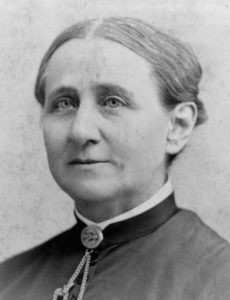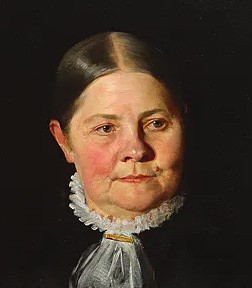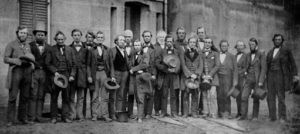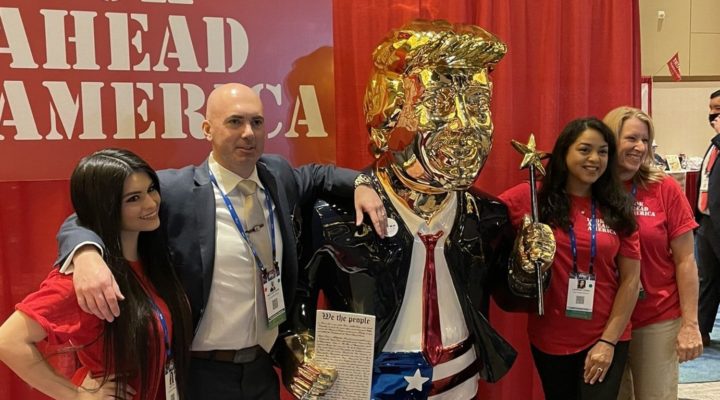Evangelicals are in trouble in the land of the free and the home of the Trump golden statue, that 6-foot sculpture that debuted at the recent Conservative Political Action Conference in Orlando. Watching the iconic ministrations surrounding it, I wondered how many of those photographed by its side might testify to an “evangelical” faith.
Those events occurred the same week that a friend sent news of a religio-political “curse” invoked by Pastor Bob Rodgers during worship services at the Evangel World Prayer Center, Louisville, Ky. In a January televised worship service, Pastor Rogers prayed: “Father, those that have lied, those that have stolen this election, those that have cheated, I place a curse of God upon them. I curse you with weakness in your body. I curse you with poverty. I curse you with the worst year you’ve ever had in the name of the Lord.” The last thing we need these days is for preachers to turn Emmanuel into a political hitman.

Bill Leonard
Earlier this year, Southern Baptist seminary presidents voted to reject Critical Race Theory, a methodology for recognizing and confronting white supremacy, labeling it incompatible with their evangelical denomination’s confession of faith. That action led numerous SBC-related Black ministers and churches to drop their SBC affiliations. Racial division in the SBC, world without end. Amen.
Those actions, among others, took me back to the roots of 19th century evangelicalism highlighted in Donald Dayton’s masterful book, Discovering an Evangelical Heritage, a work to which I’ve returned repeatedly over the years. It documents events that, like today, involved evangelical identity, politics and race, leaders the likes of Lyman Beecher and Charles Grandison Finney, schools like Lane Seminary and Oberlin College, and students who pushed evangelicalism to the gospel limit.
Lyman Beecher, Yale-educated Presbyterian minister, father of 13 little Beechers including novelist Harriet Beecher Stowe (Uncle Tom’s Cabin), and president of Lane Theological Seminary in Cincinnati, sets the stage in this excerpt from his 1835 treatise, A Plea for the West:
Amid the competitions of party and the struggles of ambition, it is scarcely possible that the clergy of a large denomination should be able to give a direction to the suffrage of their whole people, and not become for the time being the most favored denomination, and in balanced elections the dominant sect, whose influence in times of discontent may perpetuate power against the unbiased verdict of public opinion.
“The fundamental spirit and aim of Christianity is the correction of all abuses, a universal conformity to the laws of our own existence as far as revealed to the mind, and a quenchless thirst for knowledge.”
Those words reflect Beecher’s warning of the dangers posed by Roman Catholicism and its long history of church/state intrigues. At that moment, he feared that Catholics in Canada and Mexico would cut a swath of territory across the center of the U.S., creating a papal-dominated state, dividing the nation geographically and spiritually. He urged Presbyterians to send ministers who would redeem the West from “barbarism” on one hand, and “Romanism” on the other.
Rome, however, was among the least of Beecher’s worries, given the conflict over slavery and abolition sweeping 1830s America. Lane Seminary claimed to admit Black males, but only one can be documented. In 1832, Lane’s first theological class numbered about 40 students, many influenced by the mission and message of popular New York evangelist Charles Grandison Finney, who scandalized traditional Calvinists by inviting women to testify in his services, calling for immediate conversion (instead of waiting on the Spirit), and opposing chattel slavery.
Seminarians took up those causes, organizing tutorials for Black men and women and fostering public debates over slavery and abolition, issues so divisive that the school’s trustees ordered them to cease all public abolitionism and preach only a conversionist gospel.

Asa Mahan
In response, a significant portion of the student body departed Cincinnati for the Oberlin Institute, a new school in Oberlin, Ohio, that soon became Oberlin College, with abolitionist minister Asa Mahan as president. Evangelist Finney accepted the invitation to become professor of theology, but only after trustees agreed, as Dayton writes, “to leave the matter of the admission of Blacks” to the faculty, thus defining “the distinctive Christian radicalism of Oberlin College.”
“Oberlinism” attracted some 300 students its first year, ready to preach conversion and abolition, many long shut out of more conservative institutions. President Mahan declared that “the fundamental spirit and aim of Christianity is the correction of all abuses, a universal conformity to the laws of our own existence as far as revealed to the mind, and a quenchless thirst for knowledge … pertaining to the duties and interest of humanity.”
Oberlin College was the first American educational institution to admit men and women, Black and white. The school became a seedbed of early Holiness spirituality with its emphasis on both justification and sanctification, a peace and non-violence movement, and what came to be known as evangelical feminism, educating women who promoted racial and gender equality along with women’s rights.

Antoinette Blackwell
Antoinette Blackwell became the first woman to receive complete ordination in an American denomination, the Congregational Church, serving as a pastor in upstate New York. After much difficulty and criticism, she left the church for the abolitionist, women’s rights speaking circuit.

Lucy Stone
Lucy Stone became a nationally known speaker at abolitionist and women’s rights gatherings. Both graduated Oberlin in 1847, and each married a Blackwell brother. Stone refused to take her husband’s name; at their wedding they signed a pledge stating their union had “no sanction of, nor promise of voluntary obedience to such of the present laws of marriage, as refuse to recognize the wife as an independent, rational being, while they confer upon the husband an injurious and unnatural superiority, investing him with legal powers which no man should possess.” Together, they created the Woman’s Journal, a suffrage-advocacy periodical. Both Blackwell and Stone ultimately moved to the Unitarian Church, which seemed a more “open and affirming” communion.
Evangelical “Oberlinism” requires recounting in America 2021. First, it reveals that American evangelicalism has been, and in many cases remains, more diverse than its current public persona might suggest. Second, for those 19th century evangelicals, personal redemption in Christ was a doorway to the redemption of society. Most were postmillennialists who thought revivals and social action would bring in God’s New Day, after which Christ would return.

Oberlin Rescuers, Cuyahoga County Jail, April 1859. Source: Ohio Historical Society.
Finally, whatever else “Oberlin evangelicalism” was, it surely includes this: Religious experience of God’s grace in Jesus means something, not simply for the next life, but in the life we have right now. New life in Christ is no mere salvific transaction, mental assent or what some 19th century folks called “corpse cold creedalism.” It is opening the eyes of the heart to our need of personal redemption and our calling to work for justice in individuals and communities alike.
In 2021, what if the way of redemption and justice for a new evangelicalism is being brought to our generation by the descendants of those who broke the bonds of slavery?
Our pastor, Paul Robeson Ford, describes that redemptive possibility in these powerful words from his Feb. 24 BNG column. It is a redemption born of “lived human experience, and the legacy of oppression juxtaposed against resistance, and suffering juxtaposed with perseverance, that has provided our people with a unique testimony of how God saves God’s people in history, and what salvation looks like in the real world.”
Real world salvation. Radical grace. Ευαγγέλιον! Good news!
Bill Leonard is founding dean and the James and Marilyn Dunn professor of Baptist studies and church history emeritus at Wake Forest University School of Divinity in Winston-Salem, N.C. He is the author or editor of 25 books. A native Texan, he lives in Winston-Salem with his wife, Candyce, and their daughter, Stephanie.


